I have been working full-time with the SDI since 1995 and have contributed to its development and utility through research, authorship, and application. Given my role, people often ask if I am the founder or creator. I am not. That distinction rightly belongs to Elias Porter, or “Port” as his friends called him. I have assumed the mantle of SDI development, and someday that mantle will pass to someone else. I never had the opportunity to meet Porter, but I do know one word that says a lot about him: Blue (shorthand for his Altruistic-Nurturing Motivational Value System). He wanted to help people and was not overly concerned about getting credit for his work. The more I learned about him, his Relationship Awareness Theory, and the SDI, the more I became convinced that his modesty and desire to help others succeed caused him to become an overlooked figure in psychology.
This is the story of the SDI 2.0, so named to reflect its evolution since Porter created it. The SDI 2.0 is now a single assessment that produces four interrelated views of a person:
- Motivational Value System – a personality type when things are going well.
- Conflict Sequence – a personality type when experiencing conflict.
- Strengths Portrait – a ranking of productive strengths used at work.
- Overdone Strengths Portrait – a ranking of non-productive strengths used at work.
But this is not just a story of a product; it is a story of people interacting with each other and the social forces of their times. I am both the narrator and an actor in this story. I use the first person when I narrate my own involvement or add personal observations. I wrote this article because I realized that I was the sole keeper of an “oral history” of the SDI. I wanted to commit the facts to writing and hoped that the story would be interesting for anyone who uses the SDI 2.0. Let’s rewind the clock a bit and get started.
Ancient History
The SDI 2.0, like all modern personality assessments, rests on the conceptual foundation laid by earlier societies and theorists. The idea of personality types is hardly new. Ancient Chinese society described personality types based on the year of birth. The Mesopotamian society provided the 12 signs of the zodiac, which astrologists use to describe personality differences based on the day of birth. Various religious texts describe gifts from gods, many of which are like personality characteristics. In multi-theistic traditions, the gods themselves have distinctly different personalities. Long-established caste and other hierarchical social systems describe differences in people based on birth circumstances, such as being an untouchable or having royal blood. The Greek philosopher Hippocrates ascribed four personality types to the effects of varying levels of different bodily fluids (blood, bile, etc.). His four temperaments are still used, albeit in revised or renamed versions, to describe differences among people despite the fact that his biological assumptions were incorrect.
Compared with those ancient practices, the idea of psychometrics – using standardized measurement techniques to describe differences in personality – is quite recent. Modern psychometrics still rely on human-created theories and concepts, but most are supported by rigorous scientific theory and methods. That is, they are evaluated against objective standards of reliability and validity, not solely by their face-validity or popularity.
Early Influences
Sigmund Freud’s introduction of psychoanalysis was a monumental advancement in the science of understanding people. While Freud initially focused on biological drives as the explanation for behavior, he saw that these drives were shaped in the context of relationships, starting with the infant and the mother, and continuing through development and adult relationships. Freud is best known, and often justly criticized, for his early concepts, but he revised and advanced his thinking in later years. Toward the end of his life, Freud (1932) wrote a short article that described seven normal adult personality types. I will return to this article later because it has a surprising and important tie to the SDI.
Freud attracted some of the brightest minds of his time, such as Carl Jung, who went on to establish a contrary point of view regarding personality based not on interpersonal relatedness and drive, but on mental processes and preferences. The first SDI built on concepts from two people who advanced Freud’s ideas, Erich Fromm and Karen Horney. Fromm (1947) departed from Freud by focusing on the relatedness of adults in society. He described four non-productive adult orientations (Receptive, Exploitative, Hoarding, and Marketing) that would later captivate Porter and prompt him to create psychometrics to attempt to validate Fromm’s concepts. Horney (1950) brought a much-needed feminine perspective to psychoanalysis; her conceptualization of three conflict resolution strategies (compliance, aggression, and aloofness) linked to three types of responses to conflict: moving toward others, against others, or away from others.
Psychoanalytic theory, with its focus on discovering people’s motives (or drives) – be they conscious or unconscious – behind their behaviors, represents core personality as a system of drives or strivings, which may be expressed in healthy, neurotic, or destructive ways. Psychoanalysis originated, and found fertile ground, in Europe in the early 1900s; the concept and practice spread widely through publication and the exodus from Germany and neighboring countries of renowned scientists and psychoanalysts in the 1930s during the rise of fascism. Fromm and Horney emigrated to New York where US-based psychologists, such as Harry Stack Sullivan (1953) were doing work that would result in other interpersonal theories. Another key immigrant to the US, as far as the SDI story goes, was Kurt Lewin (1935), whose field theory – behavior is the result of the person interacting in the environment – influenced Elias Porter’s early education in the 1930s at the University of Oregon.
Fromm embraced and expanded on Freud’s view of happiness – lieben und arbeiten – love and work. Fromm explored the idea of human relatedness in depth, with a focus not just on interpersonal relatedness, but also on the importance of being productively related to one’s work. After some time in New York and Washington, DC, Fromm relocated to Mexico, where Michael Maccoby joined him for eight years, studying personality and social change (Fromm & Maccoby, 1970). When Maccoby returned to the United States, he built on Fromm’s foundation and applied insights from the psychoanalytic method to the practice of leadership (Maccoby, 1976). I will return to this aspect of the story later because it is important to the development of the SDI 2.0. Maccoby and Porter did not have any contact; they developed Fromm’s concepts in parallel. My own work includes the reintegration of these threads (Maccoby & Scudder, 2018).
Porter’s Relationship with Rogers
In the 1940s, when Porter studied at Ohio State University, Rogers was his teacher and an advisor during Porter’s (1942) doctoral research. Porter’s pioneering study (1943) was the first to document the effectiveness of the client-centered methods (Suhd, 1996); he used audio recordings of Rogers’ sessions with patients. After Rogers moved to Chicago in 1945, Porter and his best friend, Tom Gordon, joined him to help establish the University of Chicago’s Counseling Center. At the time, one of the center’s activities was to provide counseling to veterans returning from World War II (Kirschenbaum, 1979). Demand for counseling far outstripped capacity, and group therapy was invented by necessity. During this time, Porter, Gordon, Rogers, and others worked collaboratively. Their work contributed to a major re-focus for the entire field of psychology, from what is “wrong” with a person to what is “right.” Up until then, the prevailing definition of mental health was freedom from pathology. People without pathologies were considered to be healthy; there was no positive definition of mental health. Porter’s (1950) book, An Introduction to Therapeutic Counseling, influenced Rogers’ (1951) landmark book, Client-Centered Therapy. Rogers wrote the foreword to Porter’s book saying, “…the ingenuity which Dr. Porter has shown in developing devices which compel self-examination and facilitate attitudinal reorganization, incites my admiration. He has succeeded where to me failure seemed almost certain.” Rogers referenced Porter several times.
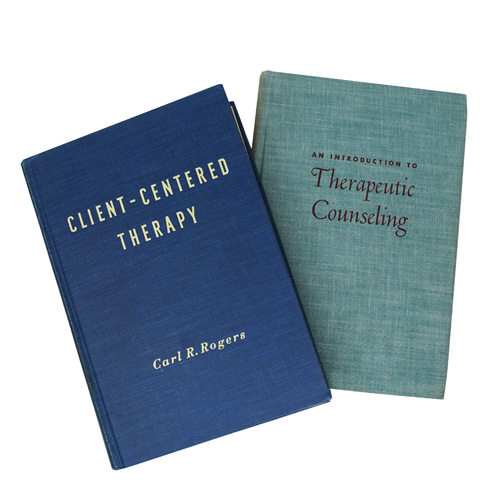
I never had the opportunity to meet Porter or Rogers, but I did get to know their friend and colleague, Tom Gordon. He told me that Porter was as much of an influence on Rogers as Rogers was on Porter. Gordon (2001) is best known for his development of communication techniques, such as I-messages and active listening, which were used widely in many training and education programs.
The group at the Chicago Counseling Center initiated a revolution in humanistic, positive psychology and human potential, long before those terms became popular. Other notable concepts have roots in this time in Chicago (Kirschenbaum, 1979). Will Schutz (who introduced me to Tom Gordon) worked at the University of Chicago with Rogers and knew Porter. Schutz is the author of Fundamental Interpersonal Relationship Orientation Theory (Schutz, 1958) and an early psychometric, the FIRO-B. Paul Hersey was significantly influenced by Rogers. He told me, “You see further from the shoulders of giants, and Carl Rogers is one of my giants.” Hersey created the Situational Leadership model of leader-follower interactions and a test to help people understand the leader-follower relationship, which was later revised by Ken Blanchard. Just one example of a modern interpretation is Stephen Covey’s fifth habit – seek first to understand, then to be understood – which was inspired by therapeutic techniques first developed by Rogers, Porter, Gordon, and others.
Unfortunately, Porter’s use of psychometrics led to a falling out with Rogers. At the time, Rogers was against any sort of personality test. He believed that the test itself would unduly influence the test-taker, who would see the test as an external authority and therefore fail to fully engage in the therapeutic relationship. But Porter persisted amid the high demand for counseling; he saw that psychometrics could do some of the work for the therapist, speed the self-discovery process, and allow the therapist to help more people. Years later, Porter and Rogers reconciled, and Rogers (1986/2005) would speak highly of Porter’s work; he even used early versions of the SDI when he was at United States International University (now the California School of Professional Psychology within Alliant International University). I learned this when I gained access to Porter’s personal correspondence, where I found a letter from Rogers to Porter asking him to send some more SDIs.
Porter’s Early Work in Psychometrics
Porter’s first experience in personality testing was to select public assistance workers at the Oregon State Public Welfare Commission in the 1930s. He created an 8-hour test to determine the ways that candidates interacted with people, placing them into one of five categories: moralistic, interpretive, reassurance-giving, probing, or empathic. During World War II he worked as a classification officer for the US Navy, where his job was to determine the most suitable roles for new recruits based on their skills, experience, and various test results.
In 1949, he read Fromm’s (1947) Man for Himself and was so intrigued by Fromm’s descriptions of personality types that he began constructing psychometrics to validate Fromm’s concepts. Porter referred to two major insights from Fromm. First, the idea that a family of traits could form an entity. This was contrary to the prevailing research mindset at the time, which was based on physical science. Psychologists were trying to isolate traits, much as physical scientists were isolating elements or variables in to show causal relationships. Porter saw that the interaction of traits, rather than isolated traits, was a more useful idea. Secondly, Porter credited Fromm with the idea that weaknesses in the context of relationships were often simply non-productive behaviors, which had productive counterparts. Porter’s first published psychometric was the Person Relatedness Test (Porter, 1953). This was developed during his time working with Rogers, where he also learned to use Q-sorts – in which people sort cards printed with personality traits – as a method of measurement that reflected the human experience of multiple traits interacting simultaneously (Stephenson, 1935). He created an unpublished Q-sort that assessed a Freudian concept, the relative strength of the Id, Ego, and Superego within a person.
The Person Relatedness Test caught the attention of Stuart Atkins and Alan Katcher, who thought that a business could be built based on the assessment. They released a product called LIFO (Atkins, Katcher, Porter, 1967) which was a slightly revised version of the Person Relatedness Test. Porter was not satisfied with the assessment, because the scale that was intended to measure Fromm’s Marketing orientation did not have an acceptable level of reliability or validity. (The Marketing orientation refers to people who constantly change according to what others – the “market” – desire.) Despite Porter’s concerns, Atkins and Katcher began selling the assessment, and the three soon dissolved their partnership.
I discovered (long after the fact when I read through Porter’s old correspondence with Stuart Atkins) that one of Porter’s oft-repeated conflict stories was about their break-up. I have an old video, where Porter relayed the story of a business dealing with a partner (he never said Atkin’s name when he told the story) who had a Red MVS and Red Stage 1 in conflict. Porter, as a Blue, felt he was not being listened to and was being taken advantage of, both creatively and financially. In his Stage 1 Blue conflict, he responded, “Mustn’t there be some type of misunderstanding?” but his “sweetness and light” approach did not get Atkins to listen to him. Then Porter went into a deep analysis (his Stage 2 Green), which Atkins dismissed. Finally, Porter was triggered into his third stage of Red, where he angrily confronted Atkins, who said in response “Aha, now the real Porter comes out.” Based on Porter’s telling of the story, it seems that Atkins only respected people who used assertive behavior. But for Porter, it took the third stage of conflict to show assertive behavior, which caused him a great deal of stress. I had the opportunity to meet Atkins and Katcher, and to interview Katcher at some length during a conference aboard the Queen Elizabeth II. I asked Katcher what caused the split with Porter. He said: “In retrospect, immaturity.” He would not say more, so I was left to make my own assumption about who was being immature.
SDI’s Early Years
After the split with Atkins and Katcher, Porter drafted a completely new assessment, this time eliminating everything related to Fromm’s Marketing orientation. He called it the Strength Deployment Inventory and founded Personal Strengths Assessment Service in 1971. At the time, he was teaching at the University of California, Los Angeles (UCLA) and serving patients in private practice. The assessment matured, and his business opportunities grew through the Los Angeles chapter of the American Society for Training and Development (since renamed the Association for Talent Development). Five years later, he incorporated his company in California as Personal Strengths Publishing. He and his wife, Sara Maloney Porter, then devoted their full-time efforts to the continued development of the SDI and the business.

The first SDI was a simple, self-scorable form, printed on goldenrod-colored card stock; they were sold for $1 each. The results were presented on three scales, the altruistic-nurturing, assertive-directing, and analytic-conserving. A simple set of score totals described the results, and there was no interpretive information provided for the “conflict” results.
In 1972, based on a suggestion from a customer, Porter introduced the SDI triangle. The first SDI triangle delineated nine personality types, two of which have the same names in the current SDI. A second version later that same year also delineated nine types, but with different boundaries. Five of the nine type-names are the same in the current SDI.
In 1973, having seen the benefits of drawing multiple people’s results on the triangle, he named it the Interpersonal Interaction Triangle and began producing it in color. The SDI was the first psychometric to use color-coded language for the results, a practice which is common today. Porter credited his wife Sara, who held a doctorate in social work, with the idea of using color-codes so people could speak about the results with ease and apply them to their daily relationships. The colors Blue, Red, and Green were chosen because Porter had noticed a slight correlation between personality type and people’s favorite color. Along with changes to the triangle, Porter made changes to the 60 assessment items to improve their reliability and validity. The 1973 version shows six personality types, the names of which all match the current SDI. Notable by its absence is the Hub, Flexible-Cohering, type. This six-type iteration remained in production until 1977.
Early SDI Triangles
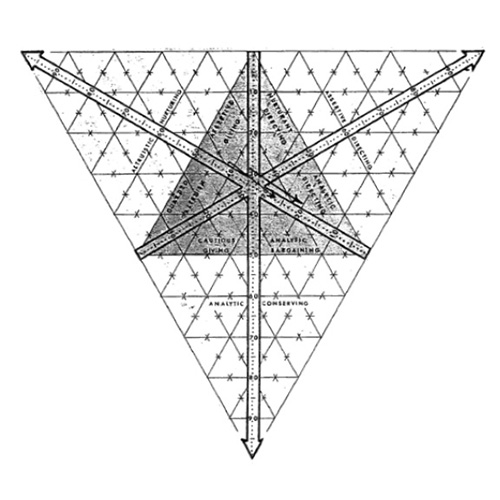
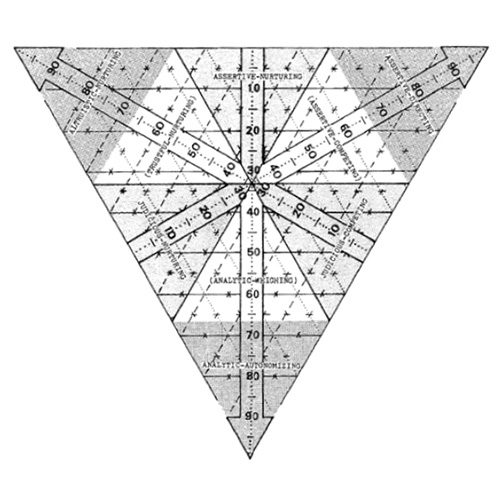
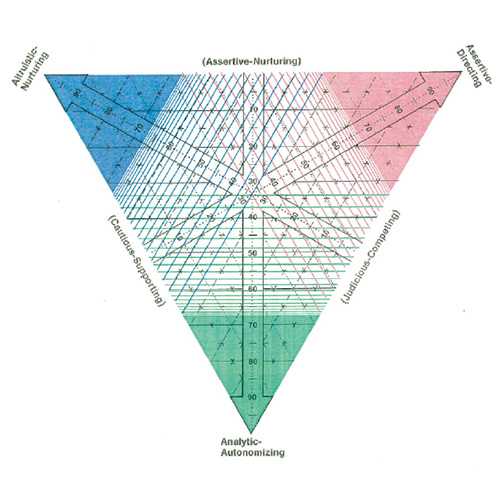
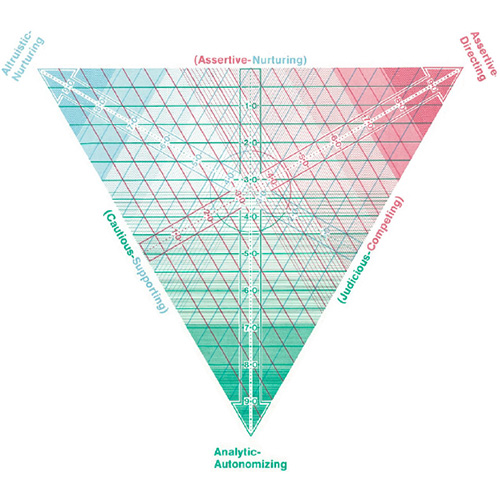
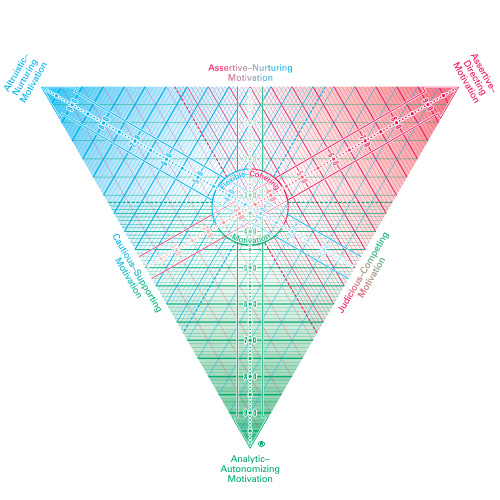
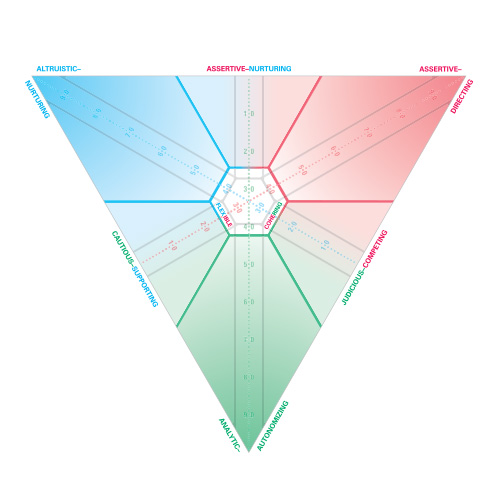
Porter continued to help others, such as Ken Thomas, to develop their ideas. In Porter’s files, I found correspondence from Thomas, thanking Porter for his assistance on what would become the Thomas-Kilmann Conflict Mode Instrument (TKI) – before Ralph Kilmann was involved. When I talked with Kilmann, he had no idea that Porter had contributed to the instrument that bore the Kilmann name. Here I discovered yet another example of Porter’s Blue modesty and desire to help others, which had the unfortunate side effect of allowing his contributions to go unrecognized.
Porter also tended to shy away from any reference that would link him to Freud. The 1970s were not the peak of Freud’s popularity. In fact, many psychologists during this time tended to criticize Freud for ideas such as the Oedipus complex and preferred to focus on more linear, mechanistic methods such as the operant conditioning made popular by BF Skinner, Pavlov, and others. Porter was never a fan of behaviorism, saying that Skinner had “…done more to hold back the field of psychology than any person he could think of.” I discovered that blistering critique in a video of a workshop where Porter was answering participants’ questions. As a side note, early in his education, Porter conducted experimental research with rats in mazes. He documented that rats learned the mazes even without the presence of any rewards or punishments (Porter and Biehl, 1943), which is contrary to Skinnerian ideas.
The emergence of the Hub, or Flexible-Cohering, type was in some ways a happy accident. Porter experienced a high degree of face validity from people whose SDI results were charted in any of the regions near the six type names on the edges of the triangle, but people whose SDI results charted in the middle of the triangle did not identify with any of the six types; they did not feel that any of the descriptions fit them. In his first manual of administration (Porter, 1973), these people were described as having “undifferentiated motivations.” As a skilled therapist and researcher, Porter began to notice a pattern in their responses. They wanted to be part of teams and wanted to adapt themselves to others’ needs and the present situation. Porter noticed that many of these traits were similar to Fromm’s Marketing orientation, which he had dismissed because his earlier psychometrics, the Person-Relatedness Test and LIFO, which attempted to directly measure the Marketing orientation, could not be properly validated.
The challenge of validating the Hub type is a persistent theme in the SDI story. With the benefit of hindsight, I can see that Freud (1932) identified it first, but he did not describe it in any meaningful way. Fromm (1947) was next, but he did not connect it to Freud’s idea. Fromm believed that the Marketing orientation was a new, emerging personality type due to a shift in social character; he described it in great detail. Porter (1973) was not satisfied with the statistical evidence to clearly differentiate the Marketing orientation from other types. Fromm and Maccoby (1970) found evidence for all of Fromm’s types except the Marketing orientation, however, this research was conducted in a farming culture where they did not expect to find the Marketing type. I have had the interesting experience of working with many people who have a Hub MVS who said that the SDI was the first personality assessment result they ever agreed with. I think this is true because Porter was astute enough to recognize that his early SDI was measuring something he did not intend to measure, then sophisticated enough to find another way to measure it, validate it, and describe it.
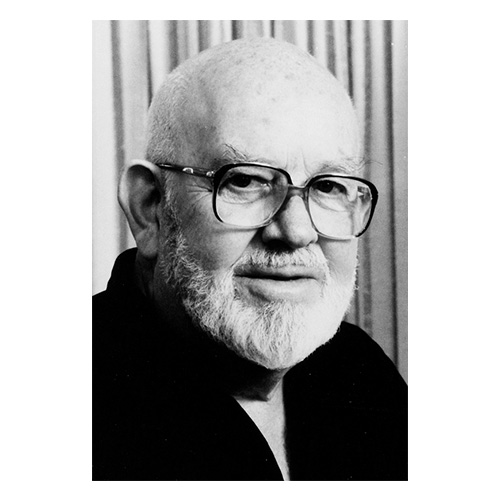
Porter was fond of saying “If something exists, it can be measured,” so he set about determining whether something different existed for people whose results were in the center of the triangle. He returned to the lists of traits in Fromm’s (1947) work that had inspired his initial work and created a card-sorting assessment of four different sets of productive behaviors. Those that we today call the Blue strengths (Caring, Helpful, etc.) correlated positively with the Blue (nurturant) motive. The Red strengths (Ambitious, Persuasive, etc.) correlated positively with the Red (directive) motive. The Green strengths (Cautious, Methodical, etc.) correlated positively with the Green (autonomous) motive. A new set of strengths, based on Fromm’s Marketing orientation (Adaptable, Open-to-Change, etc.) did not have strong correlations with any of the three SDI scales. Instead, they correlated with sets of scores where all three scales were within one standard deviation of the mean. This was the foundational insight, backed by evidence, that led Porter to inscribe a circle with a radius of one standard deviation in the triangle and add a seventh personality type to the SDI and his theory. Later, Porter would introduce a card-sort of Overdone Strengths (“Gullible” for overdone Trusting, “Arrogant” for overdone Self-Confidence, etc.). I believe Porter coined the term “Overdone Strengths” in the early 1970s even though he credited Fromm with the concept. I have not seen a reference to that term in any earlier literature, although the term is widely used today.
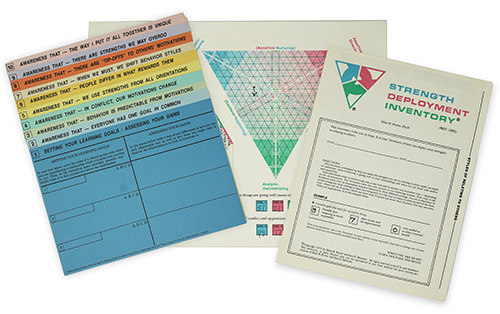
Porter had determined that three primary motives interact to form seven distinct personality types. But Porter also saw that those seven types correlated with four categories of behavior, or strengths (as initially described by Fromm). This is the reason that the SDI 2.0 today has three motive scales and four categories of strengths. Porter introduced a revised SDI that included a triangle with seven regions in 1977 (45 years after Freud’s publication of the same seven personality types). But this version of the SDI featured descriptions of only the four main personality types (Blue, Red, Green, and Hub) when things were going well. The SDI offered cursory descriptions of the three remaining types, which were often collectively referred to as “the blends” — Red-Blue, Red-Green, and Blue-Green. While the SDI offered instructions to the user about how to draw an arrow, with the dot representing the going-well state and the arrowhead representing the conflict state, no explanatory text regarding conflict was offered except for some short sentences in the SDI Manual of Administration (Porter, 1985). Unfortunately, Porter did not publish his ongoing research, and the only evidence I have been able to find is from recorded training programs that Porter led in the 1980s. During those sessions, he answered participants’ questions and described the research he conducted.
From 1977 to 1987, the SDI itself remained essentially unchanged, although Porter revised the manual several times and introduced a structured training program called the Relationship Awareness Basic Course (Porter, 1986). This course included two card-sorts, one for strengths and one for overdone strengths. In his writing, and in video recordings, he indicated that Relationship Awareness Theory was not finished. He even contemplated renaming the theory to Theory V (for validation). I found this document in a draft book section; it was written in response to the Theory X and Theory Y that were popular at the time. Porter hinted at directions for further development such as the need to more clearly understand the Hub personality type. In 1987, Porter succumbed to oral cancer, which was undoubtedly linked to the pipe he enjoyed smoking. His widow, Sara Maloney Porter continued in the business until she sold it to Bob Tomkinson and me. She had been operating the business as a way to keep Porter’s work alive and would not permit any changes to any product. It was exceedingly difficult to convince Sara that we would be true to Porter’s original ideas as we developed the business, even though Tomkinson had been a long-time customer and trusted advisor of Porter’s.
Advancing Porter’s Work
Prior to purchasing the business, I had been working as a CPA, then as a controller of a non-profit job-training organization in Los Angeles. Because the non-profit operated with federal grant funds from the US Department of Labor, I needed to document the return on investment of DOL’s money to secure funding in subsequent years. I met Tomkinson when he operated one of the most successful training and job placement subcontractors that received funding through my organization. He claimed that the SDI was the secret to his success because it helped people understand their core motives and what they found personally meaningful at work.
On Tomkinson’s recommendation, I took the SDI assessment, and he explained my results. Then I asked my girlfriend, Kim, to complete the SDI. I shared her results with Tomkinson, who then proceeded to give me two Feedback Editions of the SDI. Kim, who is now my wife, completed the Feedback Edition about how she saw me, and I completed it about how I saw her. Her view of me almost perfectly matched my view of myself. But my feedback to her was not even close. As it turned out, my feedback to her when things were going well exactly matched her conflict scores. There was a pattern in our relationship where she would say something was wrong, and I would dismiss it by saying everything seemed fine to me. The SDI and Feedback Edition results showed me that I was not seeing her accurately; this insight helped me to change my perception of her and improve our relationship.
When Tomkinson and I took over the business in 1995, I assumed the CEO role. On “day one” we had shelves full of SDIs that had not been updated since the early 1980s. We set a goal to make a new printed SDI live up to its potential. We clarified Porter’s definitions and coined the terms Motivational Value System (MVS) and Conflict Sequence (CS). I mapped the MVS and CS boundaries on the triangle so people would not have to guess where the boundaries were or refer to other resources to know their MVS and CS results. We developed the card-sorts of strengths and overdone strengths from the Basic Course to make them independent assessments. We wrote a new manual of administration and posthumously gave Porter (1996) the authorship credit. With the help of Mike Gallon, the UK distributor at the time, we gave the two-color blended MVSs equal treatment in the SDI and released the first version of the SDI that represented the full personality typology: 7 Motivational Value Systems, 13 Conflict Sequences, and card-sorts of strengths and overdone strengths. We called it the Premier Edition of the SDI and listed Porter as the author.
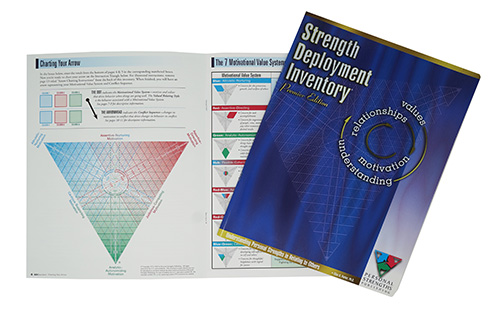
I believe Elias Porter’s most important and unique contribution to the field of psychology is the Conflict Sequence, although he characteristically did not publish it or promote it. He never even gave it a name, and he wrote very little about it, nothing more than a few sentences about each of the 13 Conflict Sequences. These short descriptive statements were behavioral in nature and found only in a technical manual and in exercise 4 of his Basic Course, which was not widely used. When we added the Conflict Sequence results to every SDI, it fundamentally transformed the assessment and the training and development programs in which it was used. Understanding conflict and conflict management was a significant focus for me and the organization. We increased the emphasis on conflict identification and management in all our training programs and released the book Have a Nice Conflict (Scudder, Patterson, & Mitchell, 2012). I felt that the key to making Porter’s concepts about conflict more useful was to focus on the motives and internal experience of conflict, which Porter alluded to, but did not fully develop. As I wrote various training programs, descriptive text for the SDI, and versions of our facilitator manuals, I focused on motives, not behavior. The essence of understanding personality in conflict is what people feel driven to do, not what they actually do. For example, a person who is experiencing a threat may feel compelled to fight with another person but instead may choose to listen to that person. This choice is fostered by self-awareness, personal development, and self-management. The internal motive to fight may never change, but the decision to fight is up to the person in each situation. Thus, the motives that define personality are stable, and behavior is variable.
In retrospect, I think I was as fascinated with Porter’s work as he was when he discovered Fromm’s work in the late 1940s. I made it my personal mission to learn everything I could about the foundations of the theory and the assessment. I had access to Porter’s working files and an archive of videotapes. I collected all his published works and read all the books he indicated as significant influences. I went to meet people who worked with Porter and Carl Rogers at Chicago, such as Will Schutz and Tom Gordon.
I also met prominent authors who did not know Porter, such as Salvatore Maddi (1996), whose book on personality was in its sixth edition and was a standard in university courses. When I reviewed the SDI and Porter’s work with Maddi in his University of California, Irvine office, he expressed regret for not knowing about Porter and said his work would have filled an important void in his text. Maddi criticized Fromm for a lack of empirical evidence for the Marketing orientation, criticized Rogers for failing to describe different personality types, and criticized Costa and McCrae’s Five-Factor model for failure to integrate the “big five” factors into any useful typology that described whole persons and the interplay between the factors. Maddi said that Porter’s Relationship Awareness Theory, and the evidence of reliability and validity that I presented, would have been a prime example of how a personality theory should be constructed; it followed and expanded on the excellent framework that Fromm had established, and it addressed the critiques he made of the other models. Sadly, there were no plans for the seventh edition of Personality Theories, a Comparative Analysis, and I added this to my mental tally of times that Porter was overlooked.
As the organization grew, we developed close relationships with customers around the world, translated products into over 20 languages, and created training programs to improve relationships in all types of organizations. During this time, we created an online platform to administer the assessments, increased the rigor of the facilitator certification experience, and continued to learn how our customers applied the SDI in real-world settings. Along with many successes, we noticed areas where the SDI could be improved.
Growing Awareness that SDI Needed Updates
We found that the Strengths Portrait and Overdone Strengths Portrait were not generating the level of insight and application that we believed they could. The integration between strengths and motives was not as clear as it could be. We began noticing that some people did not trust their self-rankings of strengths, or overdone strengths, when they used the card-sort methodology. People said that since they could see the results taking shape in the card-sort, they were influenced by how they thought they should prioritize their strengths, not how they actually did. We also noticed consistent resistance to specific strengths and the way Porter worded them, such as “Experimenter.” I would later eliminate that Hub strength from the Strengths Portrait and replace it with “Inclusive.”
The more I worked with the SDI, the more I came to find value in a systems-thinking approach, exploring the connections between the results. Subtle but important distinctions began to emerge, which Porter had not clearly identified. Examples of these connections include: people find it easier to deploy strengths from the middle or bottom of their portrait if they do not restrict the use of higher strengths or if they can be connected to the MVS; the experience in stage 1 conflict affects the experience in stages 2 and 3; the third stage of conflict acts as a filter that causes misperceptions in relationships; and overdone strengths near the bottom of the portraits tend to be conflict triggers for people. Understanding these connections between different results improved the quality of the individual and group experiences that I led. By integrating motives, conflict, and strengths, I was able to more accurately reflect people’s experiences of themselves than when I limited my interpretations to the individual elements.
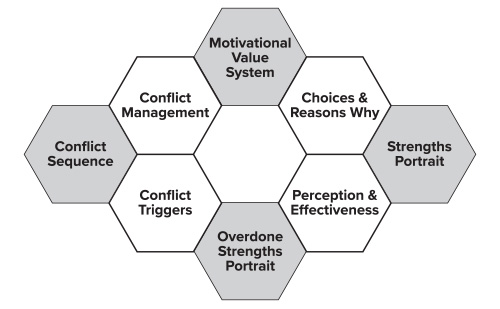
I collaborated with several students who were working on masters or doctoral degrees and supervised, sponsored, or advised them on research projects. During these projects, I found there was a paucity of published research that met current academic standards, which made it difficult for students to get faculty approval to use the SDI. Research often begets more research, and ironically, a lack of previous research can be an impediment to future research – at least in academic settings.
One day Cliff Norman, a customer with whom I enjoyed discussing theory and research, introduced me to Michael Maccoby. Norman knew my passion for Fromm’s writing and had recently met Maccoby, who worked with Fromm in Mexico for eight years, co-authored Social Character in a Mexican Village with Fromm, and advised Fromm during the writing of The Anatomy of Human Destructiveness. Maccoby and I rapidly found that our respective work was compatible; we shared a common root and had similar philosophies about human development. We integrated the SDI and his work on leadership development and co-facilitated many programs for senior leaders in corporate and government organizations.
In about 2008, I decided to continue my education and enrolled in Fielding Graduate University’s Human and Organizational Systems PhD program. While I was working on a paper for one of my early classes, I visited Maccoby at his home and happened to ask where to find an article that he had mentioned. “Just a minute,” he said as he headed toward his library. When he returned, he had Volume XXI of The Complete Psychological Works of Sigmund Freud, opened to a three-page article titled Libidinal Types. He handed it to me and said, “I think this is the beginning of SDI.” I was amazed as I read it. Here was Sigmund Freud talking about normal adults and describing personality types based on motives. The Erotic (loving) type sounded like the Blue, Altruistic-Nurturing MVS by Porter, the Narcissistic type (dominated by the Ego) sounded like the Red, Assertive-Directing MVS type, and the Obsessional (or compulsive in some translations) type sounded like the Green, Analytic-Autonomizing MVS type. Freud went on to say that no person is a pure type and that everyone is actually a blend of types, with one or more being prominent. He also described three blends of two types, each of which matched the SDI, such as the Narcissistic-Obsessional type, which he personally identified with, and which has similar characteristics to the Red-Green, Judicious-Competing type in the SDI. Freud concluded by saying there was a seventh type, one characterized by an even mix of all three primary types (as is the case with the Hub MVS type).
What hit me in that moment was that Freud, at the end of his career, had created a personality typology that matched the typology Porter had created at the end of his career. Porter had spent the greater part of his life developing and refining psychometrics until he found a valid, reliable way to measure and describe personality types. Freud and Porter came to the same conclusion through vastly different methods. But Porter’s conclusion came about 45 years after Freud’s – with no awareness of Freud’s (1932) conclusion. It seems Freud’s libidinal types had been hiding in plain sight for a long time. The article was published in Volume 1, Issue 1 of Psychoanalytic Quarterly. But unlike Freud’s well-known works from the same time, Libidinal Types was not widely known. A library search yielded less than 50 citations to this article; most were quite old. This insight sparked my own research and culminated in my dissertation (Scudder, 2013), where I used a large sample of SDI, Strengths Portrait, and Overdone Strengths Portrait results to provide the first empirical validation of Freud’s libidinal types — along with support for all four of Fromm’s non-productive orientations (including the Marketing orientation). Maccoby served on my dissertation committee, and the research gave me the data I needed to revise the assessment and improve the reporting of results.
One difference between Porter and Freud bears special attention. When Freud described the seventh type – what we know today as the Hub MVS type – he did not describe specific characteristics of this type. Freud said, somewhat enigmatically, that this type was not a type. Instead of describing it he called it the absolute norm. In my subsequent research, I found that the most consistent statistical pattern for the Hub MVS was that groups of Hubs did not show extreme mean scores on any measure, but instead showed central tendencies on every test I devised. This type cannot be easily isolated and directly measured. Fromm described it as the Marketing orientation, but Porter could not measure it reliably until he found, accidentally, that the Hub was actually the result of three motives working about equally – not a fourth, independent motive as he had attempted to measure in the Person Relatedness Test. While Porter did describe the Hub type in some detail, he struggled with capturing the essence of the type. He focused predominantly on the cohering part of the flexible-cohering (Hub) personality type, the desire to be a member of groups, to put the team before oneself, and to have a broad social circle. In my experience, people with Hub Motivational Value Systems describe themselves more frequently in terms of being interested in new ideas and perspectives, maintaining their future flexibility, and including other people in consensus-building efforts. Where Porter described a desire to be included by others, I saw a stronger drive to be the person who is inclusive of others. Some people who have worked with the SDI for a long time talk about the early versions having a “Blue bias,” which makes sense because authors tend to put some of themselves into their work; Porter had a Blue MVS, and his first stage of conflict was Blue. I have a Red-Green MVS and my first stage of conflict is Green. While these differences were obviously not by design, I do like to think that a Red-Green filter has helped to remove some of the Blue bias, thereby improving the validity and utility of the SDI.
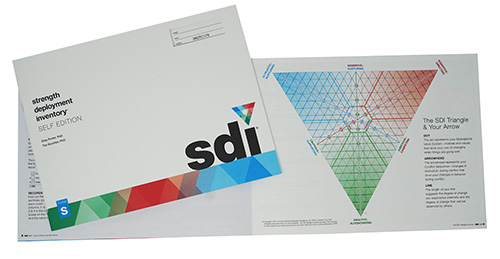
When our company introduced the revised SDI to the market under a new TotalSDI brand, my partners added my name to the product as an author. To be sure, by that time I had actually worked in the business longer than Porter did.
My contributions resulted in a product that was different and better than what we started with in the mid-1990s in some significant ways including:
- New boundaries on the SDI triangle were supported by correlations between the motive scales and the strength rankings.
- The 7 Motivational Value System regions were revised; most notably the Hub MVS became a smaller region, with a hexagonal (rather than circular) shape.
- The 13 Conflict Sequence regions were also revised, most notably a larger area for the [BRG] Conflict Sequence in the middle.
- More explanatory text for the 7 MVS types and 13 CS types.
- The clarification of connections between the MVS and CS, such as conflict triggers and the path-back from conflict to resolution.
- Clear, memorable, keyword names for the three primary motives under two conditions. People, Performance, and Process when things are going well. Accommodate, Assert, and Analyze when experiencing conflict.
- Significant changes were made to the sets of 28 strengths and overdone strengths – and to their definitions. These were driven by data obtained in my research, then the new items were subject to further validation before publication.
- The connection between behavior and motive was made clearer by the introduction of the Strengths and Reasons content. I wrote example statements that connected each of the 28 strengths to each of 7 MVS types – offering users clarity about a concept that had not been fully developed in Porter’s work. The strengths and reasons statements were one of the primary drivers of the development of the SDI 2.0.
THE SDI 2.0
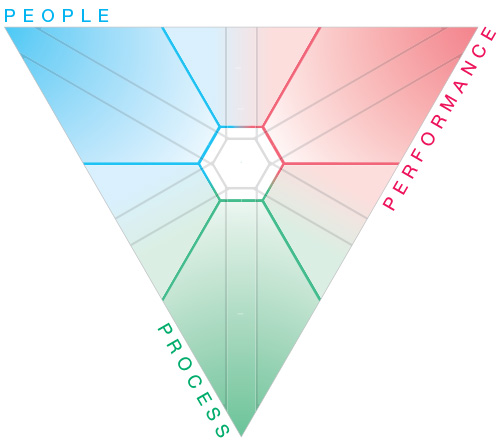
As our business grew, and Bob Tomkinson retired, we expanded the ownership team and gave the CEO role to Kevin Small. With Small on the team, we developed the Core Strengths brand and responded to our customers’ demand for more digital assessments – and less paper. Our customers also wanted the assessment experience to be available to users on their mobile devices. The card-sort method is not suitable for mobile devices. This fact, along with some concerns that the card-sort was not accurate for people who failed to read the descriptions, or for people who consciously created a picture of an internalized ideal or role expectation, led us to seek a new method.
Q-sorts (card-sorts) originated at about the same time that Porter and Rogers were working together, and they used them to assess differences in people’s ideal and actual selves (Rogers, 1961). But Q-sorts in the most recent versions of the Strengths Portrait and Overdone Strengths Portrait instructed people to choose a frame of reference before beginning the Q-sort. Some people chose a broad focus, while others focused on a specific role or situation. We noticed that the greatest utility for our customers was in comparing the core personality of people to the way they deployed, and sometimes overused, their strengths in their work.
I reworked the assessment methodology to produce results that resemble the Q-sort, but which did not present the final result until all the items had been responded to. This differs from Q-methodology, where respondents place strengths directly in the Q-sort template to indicate their relative value. My first version generated too much resistance: about 30% of respondents disagreed with their results (only 70% face validity). I restructured the assessment again, this time presenting sets of four statements that required independent ratings on a 1 to 5 scale, and tie-breaker responses in cases where two or more items were rated equally high or low. In this way, I forced each set of items into a Q-sort where one of the four must be most like the respondent, and one must be least like the respondent, even if all four received the same numerical rating on a Likert scale. From there, I developed an algorithm to produce the ordinal ranking of all 28 strengths and overdone strengths.
Statistics and practical experience convinced me that we now had a better assessment, truly a next generation of the SDI: the SDI 2.0. The SDI 2.0 is now a single assessment that produces the four interrelated views of a person that I referred to in the Author’s Note at the beginning: (1) Motivational Value System; (2) Conflict Sequence; (3) Strengths Portrait; and (4) Overdone Strengths Portrait.

The SDI 2.0 requires that people complete all items in the assessment in one sitting. This enables the production of reports that reflect the systemic nature of personality and the dynamic connections between motives and behaviors. Previously, users of the SDI and portraits were left to make their own connections between independent assessments. The SDI 2.0 is a better guide to self-discovery and personal effectiveness, because it helps people to understand themselves more fully and how they apply (or misapply) their strengths at work. In addition to the strengths and reasons content, I wrote longer, narrative descriptions for all 28 strengths and overdone strengths, which help people understand what drives them to deploy their strengths (or overdo them) at work.
The SDI 2.0 also takes advantage of technology to make the results more readily applicable to relationships. The assessment has roots in Porter’s Relationship Awareness Theory, but awareness alone doesn’t improve relationships. Relationship Intelligence (which we call RQ) is the application of insight to improve interactions and develop authentic interpersonal relationships. The SDI 2.0 is purely a digital assessment scored by an algorithm (there is no paper, self-scorable version). Its digital nature means the assessment can serve as the foundation and common language for the digital platform we have created. Not only does the platform empower users to discover their own results, but it also allows users to compare or combine their results with other people’s results, for example, those of their team members. With the digital platform, the SDI 2.0 finally fulfills the need I have heard from so many customers for so many years: “Help us build an organizational culture where positive relationships flourish, conflict is managed respectfully, and people engage their strengths most productively”. The SDI 2.0 satisfies all three of those goals.
As for my role, I still get asked if I am the founder or originator of the SDI. I say “No, but I am the current author.” And I like to playfully point out that I was just 6 years old when the SDI was first introduced, so I would have had to be quite the boy-genius (I was not). As I write this, I am still smiling about what I heard as a customer’s accidental word creation. He asked if I was the originator of the SDI. I said “No” with the above explanation. He responded, “So you’re not the originator, you’re the continuator?” “Yes,” I agreed, “I think I am.” I didn’t think that was a real word. But I liked it – so I checked the dictionary. It’s a real word. A “continuator” is a writer who creates new work based on a prior writer’s work. That is exactly how I see my role in the development of the SDI 2.0.
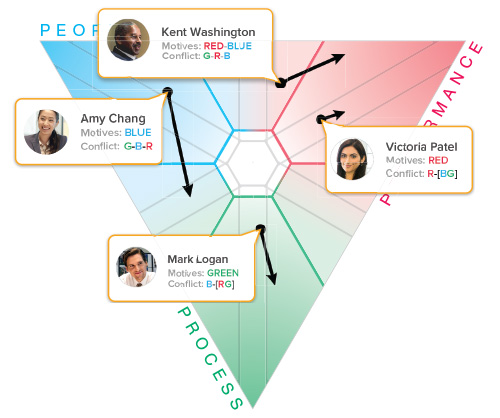
References:
Atkins, S., Katcher, A., & Porter, E. H. (1967).
LIFO: Life Orientations and Strength Excess Profile. Los Angeles, CA: Atkins-Katcher Associates.
Freud, S. (1932). Libidinal Types.
Psychoanalytic Quarterly, 1(1), 3-6.
Fromm, E. (1947).
Man for Himself: An inquiry into the psychology of ethics. New York, NY: Henry Holt and Company.
Fromm, E., & Maccoby, M. (1970).
Social Character in a Mexican Village. Englewood Cliffs, NJ: Prentice-Hall.
Gordon, T. (2001).
Leader Effectiveness Training. New York, NY: Berkley Publishing Group.
Horney, K. (1950).
Neurosis and Human Growth: The struggle toward self-realization. New York, NY: W. W. Norton & Company.
Kirschenbaum, H. (1979).
On Becoming Carl Rogers. New York, NY: Delacorte Press.
Lewin, K. (1935).
A Dynamic Theory of Personality. New York: McGraw-Hill.
Maccoby, M. (1976).
The Gamesman. New York, NY: Simon and Schuster.
Maccoby, M., & Scudder, T. (2018).
The Leaders We Need, and what makes us follow (Second ed.). Carlsbad, CA: Personal Strengths.
Maddi, S. R. (1996).
Personality Theories (Sixth ed.). Long Grove, IL: Waveland Press.
Porter, E. H. (1942).
The Development and Evaluation of a Measure of Counseling Interview Procedures. (Ph.D.), The Ohio State University, Columbus, OH. (0155823)
Porter, E. H. (1943).
The Development and Evaluation of a Measure of Counseling Interview Procedures: Part I the development. Educational and Psychological Measurement, 3, 105-126.
Porter, E. H. (1950).
An Introduction to Therapeutic Counseling. Cambridge, MA: The Riverside Press.
Porter, E. H. (1953).
The Person Relatedness Test. Chicago, IL: Science Research Associates.
Porter, E. H. (1973).
Strength Deployment Inventory: First manual of administration and interpretation. Pacific Palisades, CA: Personal Strengths Assessment Service.
Porter, E. H. (1985).
Strength Deployment Inventory: Manual of administration and interpretation. Pacific Palisades, CA: Personal Strengths Publishing.
Porter, E. H. (1986).
Relationship Awareness Basic Course: Facilitator’s guide. Pacific Palisades, CA: Personal Strengths Publishing.
Porter, E. H. (1996).
Relationship Awareness Theory (Ninth ed.). Carlsbad, CA: Personal Strengths Publishing.
Porter, E. H., & Biel, W. C. (1943).
Alleged Regressive Behavior in a Two-Unit Maze. Journal of Comparative Psychology, 35, 187-195.
Rogers, C. R. (1951).
Client Centered Therapy. Boston: Houghton Mifflin.
Rogers, C. R. (1961).
On Becoming a Person. New York, NY: Houghton Mifflin.
Rogers, C. R., Cornelius-White, J. H. D., & Cornelius-White, C. F. (1986/2005).
Reminiscing and Predicting: Rogers’ Beyond Words Speech and Commentary. Journal of Humanistic Psychology, 45.
Schutz, W. (1958).
FIRO: a Three-Dimensional Theory of Interpersonal Behavior. New York, NY: Holt, Rinehart and Winston.
Scudder, T. (2013).
Personality Types in Relationship Awareness Theory: The validation of Freud’s libidinal types and explication of Porter’s motivational typology. (Doctor of Philosophy Dissertation), Fielding Graduate University, Santa Barbara.
Scudder, T., Patterson, M., & Mitchell, K. (2012).
Have a Nice Conflict. Jossey Bass: San Francisco, CA.
Stephenson, W. (1935).
Correlating Persons Instead of Tests. Character and Personality, 4, 17-24.
Suhd, M. (1996).
Positive Regard: Carl Rogers and other notables he influenced. Palo Alto, CA: Science & Behavior Books.
Sullivan, H. S. (1953).
The Interpersonal Theory of Psychiatry. New York, NY: W.W. Norton & Company
Suggested reference for this article:
Scudder, T. (2019).
History and Development of the SDI 2.0. Carlsbad, CA: Personal Strengths Publishing.











Thank you for this extremely thorough description of the development of the SDI to its current form. I found it fascinating but, more importantly, utterly convicting. I ended up printing the key graphics and descriptions from my SDI 2.0 results and posting it over my desk so I will see it regularly, hopefully reminding me why I do what I do (and to scale down on the overdone strengths). I value the work and underlying philosophies of this assessment and am thankful for it!